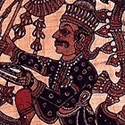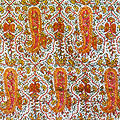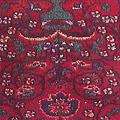Sculpture – Jinzo,
Jinzo includes
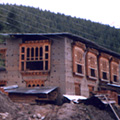
Jinzo includes
- the making of religious statues and ritual objects
- pottery and
- the construction of buildings using mortar, plaster and rammed earth.
RELIGIOUS STATUES - CLAY STATUES OR FIGURES
Every temple has large statues of various Buddhist deities and also several small statues of divinities placed in small niches. The sculptured images, like thangkas, vary greatly in size from ten cm or so in height to ten metres or even more and must be consecrated before they can become objects of worship. Bhutanese tradition maintains that making images of deities is a pious act and leads to salvation.
The tradition of commissioning and making large statues has been carried on in Bhutan in the plastic medium of clay since the 7th century. These sculptures are formulated on the iconographic principles of Buddhist art. The practice of making gigantic figures in clay seems to have originated in Central Asia where, in the absence of stone quarries, the only available medium, viz, clay was used. These statues were profusely painted and gilded to give an appearance of metal and wrapped in robes appropriate to the status and significance of the divinities. This gilded patina was renewed annually.
The practice of gilding figures of clay was replaced by that of covering them with thin plates of metal, beaten into shape and designed to cover the entire figure except the face.
The statues, made of clay, have a hollow interior. The hollow within is filled with sacred writings and other objects at the time of consecration. Sometimes trees are carved in clay or wood and statues placed on the different branches on all four sides. Such groups of spiritually related divinities and saints are referred to as "Assembly Fields" and are often used as altars.
Clay tablets
The ashes of a deceased are usually scattered in the river or mixed with clay to become votive tablets called tsatsa or enshrined in a stupa or chorten.
Torma
Images and other decorations as votive offerings known as torma are also made with butter mixed in different colours. This art is practiced mainly by the monks. In temples devoted to guardian deities, these votive offerings are made solely of butter mixed with honey, and are later put on roofs for the crows to devour.
Construction of buildings
Traditional architecture in Bhutan is characterized by the use of natural locally available and ecologically sound materials such as rammed earth, bamboo, local timbers, and stone. Even today a building is made by hand with the help of a few tools only.

Walls of rammed earth
Houses are traditionally rectangular and spaces are normally laid out in squares and rectangles. Traditional walls are constructed mainly of rammed earth or stone masonry, finished with plaster. The inner walls are of closely woven bamboo matting.
POTTERY
Pottery in Bhutan is made by hand and not on the wheel. Cooking pots, vessels for fermenting the local liquor, flower pots, pots for storage of water. Today, experimentation with the wheel to make products and glazing of objects are being done.
PRODUCTS
Idols Tara, incense holder, masks and tea pot.
Sea Shell Craft of Sri Lanka,
Owing to the abundance of small and large varieties of shells all along the Sri Lankan coast, this craft is being practised all over the country, especially in recent times. The shells are used to make a variety of products, ranging from attractively designed elephants to human figures depicting ethnic costumes of various sizes. The level of skill displayed in the craft determines the price at which it is marketed.
Owing to the abundance of small and large varieties of shells all along the Sri Lankan coast, this craft is being practised all over the country, especially in recent times. The shells are used to make a variety of products, ranging from attractively designed elephants to human figures depicting ethnic costumes of various sizes. The level of skill displayed in the craft determines the price at which it is marketed.
HISTORY & TRADITION
Historical records indicate the presence of exquisite conch shell items in ancient Sri Lanka. A beautiful shell trumpet (hak-gediya) is documented as having been given - in the earlier part of the eighteenth century - by the king Narendra Simha to a temple at Uda Nuvara. This shell trumpet is said to be one of the finest examples of Sinhalese craftsmanship. The shell is engraved and the incisions are filled with red lac; it is mounted in brass and damascened with silver. The metal mounting ends as a complete Serapendiya with clasped legs and an extension of the tail which passes round the mouth of the shell and ends in a large scroll.
Another conch shell masterpiece of the ancient times is the trumpet known as jaya saka or 'chank of victory' - this is supposed to have been dedicated by the King Rajadhi Raja Simha, on account of the King's victory over the Dutch at Gurubebile - to the Maha Devale at Kandy, where it can be found even today. The piece is mounted in gold and the mounting covers the mouth piece, apparently to ensure that none but royal lips ever be placed over it.
THE CONTEMPORARY PRODUCT RANGE
In the beach resorts of this island-country, there is a great demand for necklaces fashioned from shells of various types; coral is another material used to fashion products attractive to the tourists. When bracelets are made of conch shells then the pieces of shell are ornamented with incised lines and circles, filled with lac, and the whole bracelet is mounted in brass. Chanks, the large conch shells treasured by both the Sinhalese and the Tamil communities, continue to be considered as auspicious symbols and are kept in the houses and in places of worship, to be used on festive occasions. Engraving on conch shells is considered to be a highly specialised skill and the prices are fixed according to the rarity of the type of shell as well as the quality of workmanship.
Seashell Craft Seashell / Shimpla Hast Kala Craft Of Goa,
Owing to the abundance of small and large varieties of shells all along its long coastline Goa has a long tradition of crafting and utilizing seashells on their own or combined with other materials like brass, plastic ,wood and horn to make an assortment of products. Products made include screens, boxes, mirror frames, jewellery. Some craftsmen retain the skill of making and using flat, translucent mother -of -pearl shells in windows to diffuse daylight, a craft technique introduced by the Portuguese that can be still seen in churches and old homes. The level of skill displayed in the craft, their size and shape determines the price at which it is marketed. The technique used is to first cleanse the shells with water soaked in a weak solution of hydrochloric acid and then sundry them before processing them through cutting, filling, carving, painting, polishing and sticking them. Tools used include files, drills and cutting machines. The main concentration of craftsmen is in Madgaon, Panaji, Porvorim and Mandrem.
Owing to the abundance of small and large varieties of shells all along its long coastline Goa has a long tradition of crafting and utilizing seashells on their own or combined with other materials like brass, plastic ,wood and horn to make an assortment of products. Products made include screens, boxes, mirror frames, jewellery. Some craftsmen retain the skill of making and using flat, translucent mother -of -pearl shells in windows to diffuse daylight, a craft technique introduced by the Portuguese that can be still seen in churches and old homes. The level of skill displayed in the craft, their size and shape determines the price at which it is marketed. The technique used is to first cleanse the shells with water soaked in a weak solution of hydrochloric acid and then sundry them before processing them through cutting, filling, carving, painting, polishing and sticking them. Tools used include files, drills and cutting machines. The main concentration of craftsmen is in Madgaon, Panaji, Porvorim and Mandrem.
HISTORY & TRADITION
Historical records indicate the presence of exquisite conch shell items in ancient Sri Lanka. A beautiful shell trumpet (hak-gediya) is documented as having been given - in the earlier part of the eighteenth century - by the king Narendra Simha to a temple at Uda Nuvara. This shell trumpet is said to be one of the finest examples of Sinhalese craftsmanship. The shell is engraved and the incisions are filled with red lac; it is mounted in brass and damascened with silver. The metal mounting ends as a complete Serapendiya with clasped legs and an extension of the tail which passes round the mouth of the shell and ends in a large scroll.
Another conch shell masterpiece of the ancient times is the trumpet known as jaya saka or 'chank of victory' - this is supposed to have been dedicated by the King Rajadhi Raja Simha, on account of the King's victory over the Dutch at Gurubebile - to the Maha Devale at Kandy, where it can be found even today. The piece is mounted in gold and the mounting covers the mouth piece, apparently to ensure that none but royal lips ever be placed over it.
THE CONTEMPORARY PRODUCT RANGE
In the beach resorts of this island-country, there is a great demand for necklaces fashioned from shells of various types; coral is another material used to fashion products attractive to the tourists. When bracelets are made of conch shells then the pieces of shell are ornamented with incised lines and circles, filled with lac, and the whole bracelet is mounted in brass. Chanks, the large conch shells treasured by both the Sinhalese and the Tamil communities, continue to be considered as auspicious symbols and are kept in the houses and in places of worship, to be used on festive occasions. Engraving on conch shells is considered to be a highly specialised skill and the prices are fixed according to the rarity of the type of shell as well as the quality of workmanship.
Seep-Ka-Kaam/Mother-of-Pearl Work of Rajasthan,
Seep ka kaam is a popular craft practiced in the Jodhpur city of Rajasthan. Products such as boxes. lamp stands, candle stands, ashtrays, chessboard, flowerpots and photo frames etc are created under this craft-form. Tools such as grinder, metal cutter, shell cutter and wood saw are used for the crafting purposes.
Seep ka kaam is a popular craft practiced in the Jodhpur city of Rajasthan. Products such as boxes. lamp stands, candle stands, ashtrays, chessboard, flowerpots and photo frames etc are created under this craft-form. Tools such as grinder, metal cutter, shell cutter and wood saw are used for the crafting purposes.
Shadow Puppets in Leather,
The shadow play or puppet show with leather figures is an art form of great antiquity. References to it are found as early as the 12th century. Shadow play flourished in different parts of India and the figures of the various characters of the play were designed in leather, with the play being performed by projecting the shadows of these puppets on to a cloth screen. In Karnataka the puppeteers are well versed in music and in the themes of the great epics. Andhra Pradesh has several families of traditional puppeteers called tolu bommalata. Odisha has a tradition of leather puppets and of puppet shows known as ravanchaya. In Kerala, tolpava koothu (tol means leather, pava means puppet, and koothu means play) originated in the Palaghat district where it is still performed in the temples of Bhadrakali as part of the ritualistic worship of the goddess. The techniques used to produce the puppets is complex. Goat or sheep leather is used and skin is first stretched taut and is nailed at the corners to keep it in position. It is then smeared and rubbed with ash, and exposed to the sun till it is dry. The puppet figure is then drawn on the leather and cut out with a fine chisel. Ornaments and clothing are drawn by drilling different kinds of holes in the skin for which special pointed chisels are used. Colour plays an important and ritual part in the making of these puppets. The colours used to tint and paint the leather are obtained from vegetable and mineral sources. These colours retain their lustre and brightness for a long time. To prevent the puppets from bending a thin strip of smoothened bamboo is fastened vertically along the middle on either side. The arms of the puppet are provided with movable joints. There are puppets for birds, animals, and trees and even for the sea. Puppets of deer and snakes are provided with joints that enable them to bend and move their bodies. In order to find new markets the makers of the leather puppets have used the same techniques to make lampshades in different shapes and sizes. These create striking illumination on being lighted.
The shadow play or puppet show with leather figures is an art form of great antiquity. References to it are found as early as the 12th century. Shadow play flourished in different parts of India and the figures of the various characters of the play were designed in leather, with the play being performed by projecting the shadows of these puppets on to a cloth screen. In Karnataka the puppeteers are well versed in music and in the themes of the great epics. Andhra Pradesh has several families of traditional puppeteers called tolu bommalata. Odisha has a tradition of leather puppets and of puppet shows known as ravanchaya. In Kerala, tolpava koothu (tol means leather, pava means puppet, and koothu means play) originated in the Palaghat district where it is still performed in the temples of Bhadrakali as part of the ritualistic worship of the goddess. The techniques used to produce the puppets is complex. Goat or sheep leather is used and skin is first stretched taut and is nailed at the corners to keep it in position. It is then smeared and rubbed with ash, and exposed to the sun till it is dry. The puppet figure is then drawn on the leather and cut out with a fine chisel. Ornaments and clothing are drawn by drilling different kinds of holes in the skin for which special pointed chisels are used. Colour plays an important and ritual part in the making of these puppets. The colours used to tint and paint the leather are obtained from vegetable and mineral sources. These colours retain their lustre and brightness for a long time. To prevent the puppets from bending a thin strip of smoothened bamboo is fastened vertically along the middle on either side. The arms of the puppet are provided with movable joints. There are puppets for birds, animals, and trees and even for the sea. Puppets of deer and snakes are provided with joints that enable them to bend and move their bodies. In order to find new markets the makers of the leather puppets have used the same techniques to make lampshades in different shapes and sizes. These create striking illumination on being lighted.
Shaphee Lanphee of Manipur,
Shaphee Lanphee is a traditional textile fabric, usually a shawl, which has embroidered motifs with cotton threads. The shawls are made by the Meitei women of Manipur. In the past, the king presented this fabric as a gift to soldiers to honour them for their bravery in a successful war. Praiseworthy chiefs of Manipur also received such shawls.
Shaphee Lanphee is a traditional textile fabric, usually a shawl, which has embroidered motifs with cotton threads. The shawls are made by the Meitei women of Manipur. In the past, the king presented this fabric as a gift to soldiers to honour them for their bravery in a successful war. Praiseworthy chiefs of Manipur also received such shawls.
Shawl Weaving and Embroidery of Jammu and Kashmir,
The Kashmiri shawl is the most cherished acquisition of a lady and is believed to be indigenous to Kashmir. By way of technique, it can be categorised into two main types --- the loom-woven kani shawl and the needle embroidered sozini shawl. These shawls are much in demand during winter owing to their warmth, colour(s), texture(s), design(s) and softness. Kashmiri artisans depict the natural bounty of the valley on the shawl through embroidered floral motifs. The raw materials mainly used are raffal and pashmina fabrics. The kani shawl is a length of intricately woven material used as a wrap around the body. It is widely known as a jamawar. Kings and courtiers are supposed to have bought this by the yard (war) and wore it as a gown or robe (jama ). Such a shawl is in a class by itself, and possesses an extremely fine texture. Kani is the little wooden stick used as a spoon to weave this wonder, known colloquially as a kani shawl. Sometimes as many as 50 kanis are used with different coloured threads for single weft reflecting the intricacy of design. The fine texture and the complex designs mean that artisans can seldom weave more than an inch a day. Kanihama, a village in the western part of Kashmir, has a monopoly over the weave and the trade in kani shawls. The pashmina is made from the wool obtained from the pashmina goat, known locally as Lena Rama, and found mostly found in the Changthang area of Ladakh. Pashmina wool is available in a colours like white, brown, gray, and black. The average height of a pashmina goat ranges from 18-224 inches and it yields 250- 300 grams of pashmina per season, comprising 60 per cent fibre and 40 per cent hair. Pashminas are famous for their lustre, texture, softness, and warmth. The colours are richly blended in beautiful varied patterns. Shahtoosh wool is obtained from Tibetan antelopes found in Tibet and Ladakh. The animal also called chiru measures 4 feet in length and 31 inches on the shoulders, and weighs between 41 and 45 kg. The shastoosh is fine enough to pass through a finger ring and is thus also known as the ring shawl. Presently the production of shahtoosh shawls has been banned by the Central Government owing to the needs of wildlife protection.
The Kashmiri shawl is the most cherished acquisition of a lady and is believed to be indigenous to Kashmir. By way of technique, it can be categorised into two main types --- the loom-woven kani shawl and the needle embroidered sozini shawl. These shawls are much in demand during winter owing to their warmth, colour(s), texture(s), design(s) and softness. Kashmiri artisans depict the natural bounty of the valley on the shawl through embroidered floral motifs. The raw materials mainly used are raffal and pashmina fabrics. The kani shawl is a length of intricately woven material used as a wrap around the body. It is widely known as a jamawar. Kings and courtiers are supposed to have bought this by the yard (war) and wore it as a gown or robe (jama ). Such a shawl is in a class by itself, and possesses an extremely fine texture. Kani is the little wooden stick used as a spoon to weave this wonder, known colloquially as a kani shawl. Sometimes as many as 50 kanis are used with different coloured threads for single weft reflecting the intricacy of design. The fine texture and the complex designs mean that artisans can seldom weave more than an inch a day. Kanihama, a village in the western part of Kashmir, has a monopoly over the weave and the trade in kani shawls. The pashmina is made from the wool obtained from the pashmina goat, known locally as Lena Rama, and found mostly found in the Changthang area of Ladakh. Pashmina wool is available in a colours like white, brown, gray, and black. The average height of a pashmina goat ranges from 18-224 inches and it yields 250- 300 grams of pashmina per season, comprising 60 per cent fibre and 40 per cent hair. Pashminas are famous for their lustre, texture, softness, and warmth. The colours are richly blended in beautiful varied patterns. Shahtoosh wool is obtained from Tibetan antelopes found in Tibet and Ladakh. The animal also called chiru measures 4 feet in length and 31 inches on the shoulders, and weighs between 41 and 45 kg. The shastoosh is fine enough to pass through a finger ring and is thus also known as the ring shawl. Presently the production of shahtoosh shawls has been banned by the Central Government owing to the needs of wildlife protection.
Shazar Stone Crafts of Banda, Uttar Pradesh,
Shazar is crafted only at Banda in India. it is crafted in a very old traditional fashion with a wooden bow and a thin steel wire called 'Kaman'. Stones are mounted over a wooden stand called 'Khunta' and sliced by this bow with the help of silicon carbide powder in 2 to 4 mm thickness. These stones slices are then designed , trimmed, shaped and polished with utmost care and precision as the depositions are in micron thickness only. An ordinary looking pebble when cleaned and crafted by skilled artists becomes beautiful 'Shazar Stone'
Shazar is crafted only at Banda in India. it is crafted in a very old traditional fashion with a wooden bow and a thin steel wire called 'Kaman'. Stones are mounted over a wooden stand called 'Khunta' and sliced by this bow with the help of silicon carbide powder in 2 to 4 mm thickness. These stones slices are then designed , trimmed, shaped and polished with utmost care and precision as the depositions are in micron thickness only. An ordinary looking pebble when cleaned and crafted by skilled artists becomes beautiful 'Shazar Stone'
Sheep Wool Blankets and Woollen Carpets of Bangladesh,
Handmade blankets made from sheep wool in Chapainawabgonj and woollen floor carpets of Sonagazi are acclaimed all over Bangladesh.
Handmade blankets made from sheep wool in Chapainawabgonj and woollen floor carpets of Sonagazi are acclaimed all over Bangladesh.
Sheep, Yak, Wool Weaving of Uttarakhand,
The Almora district of Uttaranchal comprises the Kumaon region that has evergreen forests, meadows and lakes. The Almora town is situated on the banks of river Kosi. The kumaonis are the farmer communities who terrace their fields. Spinning and weaving is a common domestic activity. The shawls of the Almora region are made with nettle fibres that grow in abundance in the region. The nettle or bichchu buti grows wild as undergrowth particularly in Almora and Chamoli region. These stem fibres are pliable and thus easily woven into fabric. The nettles are harvested by the villagers and stem retting is done in the river for few days. Once the stem softens and swells the stalk is beaten and thrashed on boulders to release the fibres. The fibre is bundled up and sold to the weavers. The weavers treat the raw fibres as per the finish required. The fibre is brown in appearance. This fibre is spun into yarns and knitted or woven into shawls. The other products made of nettle fibres are stoles and bags.
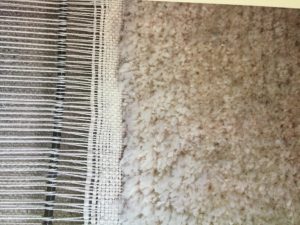
The Almora district of Uttaranchal comprises the Kumaon region that has evergreen forests, meadows and lakes. The Almora town is situated on the banks of river Kosi. The kumaonis are the farmer communities who terrace their fields. Spinning and weaving is a common domestic activity. The shawls of the Almora region are made with nettle fibres that grow in abundance in the region. The nettle or bichchu buti grows wild as undergrowth particularly in Almora and Chamoli region. These stem fibres are pliable and thus easily woven into fabric. The nettles are harvested by the villagers and stem retting is done in the river for few days. Once the stem softens and swells the stalk is beaten and thrashed on boulders to release the fibres. The fibre is bundled up and sold to the weavers. The weavers treat the raw fibres as per the finish required. The fibre is brown in appearance. This fibre is spun into yarns and knitted or woven into shawls. The other products made of nettle fibres are stoles and bags.


Sheet Copper Work in Vessels from Uttarakhand,
Sheet copper is cold-forged over swage blocks and stones under the blows of hammer and mallets. To soften a fatigued part, it is annealed over a small fire. Sheet copper is used to making many utilitarian wares for the community. These include large bellied water pots, cylindrical water filers and shallow cooking vessels. Large vessels are made in three pieces-the mouths, the body and the bottom are assembled together by brazing the joints with a filler of water, borax, and metal. the brazing is always done from inside. Drums have dovetailed joints while vessels have overlapping ones. once all the joints are sealed the artisan knocks on the walls to listen for the breaks in the brazing done. Over time the vessel can break from anywhere but the joints.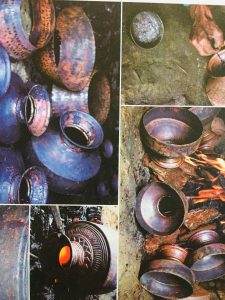



Sheet copper is cold-forged over swage blocks and stones under the blows of hammer and mallets. To soften a fatigued part, it is annealed over a small fire. Sheet copper is used to making many utilitarian wares for the community. These include large bellied water pots, cylindrical water filers and shallow cooking vessels. Large vessels are made in three pieces-the mouths, the body and the bottom are assembled together by brazing the joints with a filler of water, borax, and metal. the brazing is always done from inside. Drums have dovetailed joints while vessels have overlapping ones. once all the joints are sealed the artisan knocks on the walls to listen for the breaks in the brazing done. Over time the vessel can break from anywhere but the joints.




Sheet Metal Craft / Thattar Ka Kaam Of Kullu, Himachal Pradesh,
Sheet metal crafts in Kullu create products for the ritual requirements of the huge number of Hindu temples in the area. The temple products crafted include sheet metal objects of silver like the wind instruments, the Karnal; the S-shaped trumpet, the Narsingha; the mohra, the sheet metal masks depicting the deities; chattries, the auspicious umbrellas used to shield as a cover for the deities and other ritual objects. For secular purposes a wide range of sheet metal products of brass and silver are crafted including utensils and musical instruments for home-based temples. The technique used is by shaping the metal sheets by the process of die-transfer, then die-pressing or beating to obtain the desired shape. The object is then heated in a coal-fired kild to soften it and grant it luster. The figurative details are carved on and the object given a high polish with lemon leaves. The tools used are basic - hammer, chisels, files, punches and tongs.
Sheet metal crafts in Kullu create products for the ritual requirements of the huge number of Hindu temples in the area. The temple products crafted include sheet metal objects of silver like the wind instruments, the Karnal; the S-shaped trumpet, the Narsingha; the mohra, the sheet metal masks depicting the deities; chattries, the auspicious umbrellas used to shield as a cover for the deities and other ritual objects. For secular purposes a wide range of sheet metal products of brass and silver are crafted including utensils and musical instruments for home-based temples. The technique used is by shaping the metal sheets by the process of die-transfer, then die-pressing or beating to obtain the desired shape. The object is then heated in a coal-fired kild to soften it and grant it luster. The figurative details are carved on and the object given a high polish with lemon leaves. The tools used are basic - hammer, chisels, files, punches and tongs.
Sheet Metal Work of Uttar Pradesh,
Lavishly ornamented products are created under the craft of sheet metal work in Uttar Pradesh. The work is a combination of ubhar naqqashi or repousse with jaal ka kaam or openwork. Products such as paandaans, cooking pots/deg, metal plate/sini, small deg/patili, water pot/tonti lota, standards/alam are crafted by the artisans. Tools such as chisels/kalam, divider/prakaar, iron slab/nihai, lead/sisa, paper stencils/khakha are used for the crafting process.
Lavishly ornamented products are created under the craft of sheet metal work in Uttar Pradesh. The work is a combination of ubhar naqqashi or repousse with jaal ka kaam or openwork. Products such as paandaans, cooking pots/deg, metal plate/sini, small deg/patili, water pot/tonti lota, standards/alam are crafted by the artisans. Tools such as chisels/kalam, divider/prakaar, iron slab/nihai, lead/sisa, paper stencils/khakha are used for the crafting process.
Shell Craft of Andaman & Nicobar,
The large and beautiful shells found in abundance in the Andaman and Nicobar Islands. are cleaned and polished before being used to make ashtrays, small boxes, bangles, table lamps, and jewellery. An interesting and beautiful resource is the tortoise shell which is often inlaid with silver, and used to make jewellery and decorative artefacts such as rings and crosses to be worn around the neck. Shell, because of its light colour and luminous properties, is also being used for inlay work .
The large and beautiful shells found in abundance in the Andaman and Nicobar Islands. are cleaned and polished before being used to make ashtrays, small boxes, bangles, table lamps, and jewellery. An interesting and beautiful resource is the tortoise shell which is often inlaid with silver, and used to make jewellery and decorative artefacts such as rings and crosses to be worn around the neck. Shell, because of its light colour and luminous properties, is also being used for inlay work .



